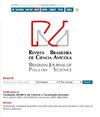Natural Growth Promoters Replacing Traditional Growth Promoters in Diets for Light Replacement Pullets: A Systematic Approach
IF 1.1
4区 农林科学
Q3 AGRICULTURE, DAIRY & ANIMAL SCIENCE
引用次数: 0
Abstract
The effect of using natural growth promoters (NGP) to replace traditional antimicrobials on performance, biometry of digestive and reproductive organs, sexual maturity and bone characteristics of replacement pullets was evaluated; and the relationship between these variables according to the diets was verified. Eight-week-old birds were randomly assigned to a completely randomized design and fed different diets: negative control (without growth promoters); positive control - conventional growth promoter; organic acids (OA); symbiotic (S); essential oil (EO); OA + S; and EO + S. The performance, relative weight of digestive and reproductive organs and length intestines, height and crest length, sternum length, bone quality and sexual maturity of birds were similar ( p> 0.05) between treatments. The heat map combined with cluster analysis showed a uniform static pattern with the formation of three horizontal groups formed by the treatments: 1) negative control, S and OA + S; 2) positive control and OE and 3) OA and OE + S. A null relationship between the treatments and the variables under study was observed. The principal components analysis revealed an association of variables in three components with 60.55% of variation. NGP can replace traditional promoters, as they do not interfere with performance, biometrics or sexual maturity. Height and length are predictive variables for the development of reproductive organs, especially the oviduct. A similarity was identified through multivariate techniques between symbiotic and organic + symbiotic acids; positive control and essential oils; and organic and symbiotic acids + essential oils.用自然生长促进剂替代传统生长促进剂饲喂轻替代仔鸡的系统方法
本文章由计算机程序翻译,如有差异,请以英文原文为准。
求助全文
约1分钟内获得全文
求助全文
来源期刊

Brazilian Journal of Poultry Science
农林科学-奶制品与动物科学
CiteScore
1.80
自引率
9.10%
发文量
60
审稿时长
>12 weeks
期刊介绍:
A Revista Brasileira de Ciência Avícola surgiu em 1999 a partir da necessidade que a comunidade científica possuía de um periódico para veiculação e publicação de seus trabalhos, com a publicação de três números anuais.
A Revista conta hoje com um corpo editorial altamente qualificado e com artigos científicos desenvolvidos pelos maiores especialistas da área, o que a cada dia atrai mais leitores em busca de inovação e respaldo técnico.
Devido à credibilidade que conquistou pelos esforços de sus autores, relatores e revisores, a Revista ganhou caráter de coleção, sendo consultada como fonte segura de estudo desenvolvidos na Avicultura.
A partir de 2003 – volume 5 -, a Revista passou a chamar-se Brazilian Journal of Poultry Science, e todos os trabalhos passaram a ser publicados em inglês. No mesmo ano subiu para quatro o número de revistas por volume, ampliando-se assim os trabalhos publicados anualmente.
 求助内容:
求助内容: 应助结果提醒方式:
应助结果提醒方式:


